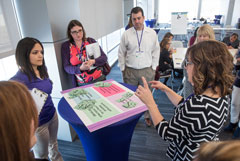March 1, 2017
A reflection of the continuous improvement to the hiring process
Submitted by Human Capital Services- Talent Acquisition

It has been approximately one year since Human Capital Services' Talent Acquisition team automated the newly redesigned and streamlined hiring process and this is an opportunity to reflect on the team's progress.
"The team is grateful that university stakeholders trusted us to lead and execute the digital transformation to attracting a highly talented, diverse workforce," said Roberta Maldonado Franzen, director. "We continue to move forward with continuous improvements and add new resources to assist in the hiring of faculty and staff and so the journey continues."
In 2015, the process to hire candidates to join the university was conducted via paper. There were 139 steps to hire faculty, 46 decisions needed to be made to hire unclassified staff, and 23 times when the paper was reworked to hire a university support staff. It took on average 108 working days to hire faculty and 80 days to hire unclassified staff (data was not readily available for university support staff positions). There were seven forms to initiate and identify a new hire and the forms required wet signatures by the appropriate administrators.
Now, the process to hire candidates to join the university is streamlined and automated via PageUp applicant tracking system. The improvements resulted in 58 percent elimination of steps to hire faculty, 67 percent decreased decisions made to hire an unclassified professional, and 69 percent reduction of rework to hire university support staff. The average time to accept a faculty position is 48 days (2017-2018 academic hiring data still pending), 41 days for unclassified and 46 days for university support staff positions.
Talent Acquisition utilizes social media — i.e. Twitter and Facebook — to attract candidates which embrace a cost-effective centralized approach to sharing information about jobs. The team is able to utilize data to let HCS know where highly talented, diverse applicants are learning of the positions and then tailor the advertising approach. For example, in 2015, 127 women learned of university positions from LinkedIn and 680 minorities learned of university positions from HigherEdJobs. This information helps guide HCS's decision on effective outreach programs to attract a highly talented, diverse workforce. The team continues to centralize resources and reduce the cost to advertise positions at The Chronicle, Inside Higher Ed, Higher Ed Jobs, LinkedIn, Indeed, Facebook, Twitter, and the university career site.
Where HCS is headed as K-State moves forward to meet the vision of K-State 2025. Talent Acquisition's mission is to establish best practices that effectively target and acquire diverse top talent. The team is focused on enhancing internal recruitment capacity and practice a modern consultation approach to assist internal and external customers daily. For instance, as each search process comes to a conclusion, the hiring manager receives a survey to assess their experience on services provided. The team compiles the feedback and develops action plans to continue to improve the practice of attracting a highly talented, diverse workforce. Another area of focus is collaborating with stakeholders to utilize K-State 2025 strategic plans to prioritize areas impacted by hiring.
"Our goal is to use the data to help shape our hiring decisions," Maldonado Franzen said.
